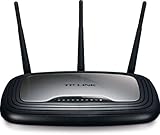OpenWRT on TP-Link TL-WR2543ND
If you want to dive straight into install instructions then head over to the TP-Link TL-WR2543ND article on the OpenWRT Wiki.

Why?
When my son smashed the screen on my iPad 2 I think he also damaged the WiFi antenna. I had to be just about be sitting on top of a 2.4Ghz hotspot to get any 802.11g/n signal. 5GHz seemed OK though, so rather than getting the iPad repaired again I thought it would be easier/cheaper to get an access point that supported 802.11a.
I didn’t really want a router, but standalone dual band access points don’t seem to be a thing, so I went for the TL-WR2543ND as it was pretty cheap on Amazon (£40.77 when I got it, now £37.99 on Amazon.co.uk [1]).
When the router arrived it was a bit of a disappointment. Firstly I thought that dual band would mean both bands at once (it doesn’t), and secondly there was no obvious way to get it working nicely on my usual home network subnet. I had to treat the home network as the WAN, and then have another subnet for devices connected to the router.
Having done some other upgrades to the home network I wanted a 5 port gigabit switch in the lounge, and it would be handy to have the 5Ghz access point there too. I just needed some way to liberate the WAN port on the router, and there was no way to do that with stock firmware.
OpenWRT
OpenWRT is an open source firmware platform for routers. I’ve previously used in on an older TP-Link device that I had in the lounge, and installation onto the TL-WR2543ND was a breeze.
Using the web interface from a laptop connected to one of the wired LAN ports I ran through initial configuration:
- Enabled SSH, disabled password login and installed a key
- Set up WiFi
- Removed dnsmasq to avoid clashes with the DHCP/DNS elsewhere on the network
- Gave the LAN interface a static IP on my usual subnet
Almost there…
I now had a router with a 4 port switch and 5GHz WiFi, but I needed that extra port. At this point I tried bridging the LAN (eth0.1) and WAN (eth0.2) interfaces. I thought I had it working (stuff plugged into the WAN port was pingable from elsewhere on the network), but on power cycling no traffic passed on the switch, and I couldn’t connect to the web or SSH interfaces.
Disaster :(
Recovery
Now the stuff about serial port recovery from the install instructions came into its own. I’d stupidly locked myself out of the device, and I needed a way back in. Luckily it was pretty easy to solder a few header pins into the right place, and the FTDI adaptor that I got for my Nanode let me connect a serial terminal. I was back into the Linux shell[2], and a bit of hacking at /etc/config/network to remove the bridge had me back in over the network.
What actually worked
Having got myself back in (and made a backup of a working network config in case I messed it up again) I tried unsuccessfully to make bridging work. Even when I managed to do this in a way that didn’t lock me out of the router it seemed to cause ARP floods. I was doing the software equivalent of plugging a cable into two ports of the same device.
The correct approach was to disable VLAN functionality in the Network->Switch menu (I also deleted VLAN 2 and set port 0 to untagged on VLAN 1).
This does the trick because the WAN port is/was just a different VLAN on the same switch as the LAN ports, so if I want them all to work together then naturally I just treat them as part of the same VLAN (by not having any distinct VLANs at all).
Conclusion
I’ve now got what I want – a 5 port switch with attached 5GHz access point, rather than what I bought – a dual band WiFi router. Less is more.
Notes:
[1] I was going to put in an Amazon.com link for US readers, but it seems to have been discontinued.
[2] There was no need to reinstall the firmware
Filed under: howto, technology | 2 Comments
Tags: 2.4GHz, 5GHz, 802.11a, firmware, gigabit, OpenWRT, router, serial, switch, TL-WR2543ND, TP-Link

2 Responses to “OpenWRT on TP-Link TL-WR2543ND”